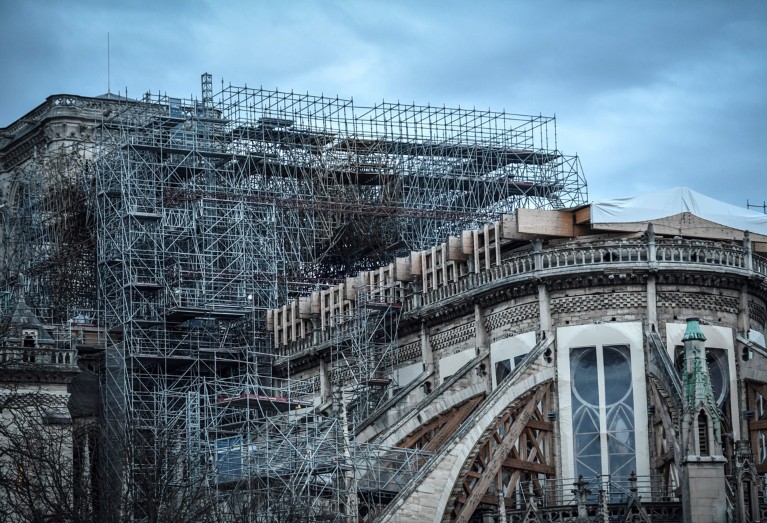Hello Nature readers, would you like to get this Briefing in your inbox free every day? Sign up here

The devastating fire at Notre-Dame de Paris last April destroyed the cathedral’s roof and spire.Credit: Stephane De Sakutin/AFP/Getty
Notre-Dame fire reveals its bones to science
Last year’s fire at Paris’s beloved cathedral shocked the world. Now, scientists at the French national research organization CNRS are embarking on a project to illuminate how the 850-year-old building was constructed. More than 100 researchers in 25 laboratories will have unprecedented access to the cathedral’s fabric — including timber, metalwork and the building’s foundations. The research could “write a new page in the history of Notre-Dame, because there are currently many grey areas”, says historian Yves Gallet.
Mystery virus identified in China
A new coronavirus is the probable cause of a pneumonia-like illness that has affected dozens of people in central China. Researchers have sequenced the virus’s genome, and 15 patients have tested positive for the infection.
SpaceX tests black satellite
SpaceX has launched a satellite that is partially painted black to test whether it reduces the spacecraft’s visibility. ‘DarkSat’ addresses fears that the thousands of satellites planned by the company will flood the night sky with light pollution. The launch of the first 60 satellites in June caused panic among astronomers, some of whom shared images of dozens of light trails obscuring their observations.
Russian journals retract more than 800 papers
Academic journals in Russia are retracting more than 800 papers following a probe by the Russian Academy of Sciences (RAS). An independent RAS commission used software and manual checking to identify plagiarism or self-plagiarism in hundreds of journals across the sciences, medicine and law. The commission recommended the retraction of 2,528 articles and has called for 5 journals that refused to cooperate to be censured.
Reference: Commission report to the RAS (in Russian)
Features & opinion

In some animals, three blade-like proteins together form the Piezo1 channel, which helps their cells to sense touch.Credit: David S. Goodsell/RCSB PDB
How we feel the force
From orienting ourselves in space to sensing a full bladder, our sense of touch suffuses the functioning of our bodies both inside and out — yet it’s the least understood of our senses. Now researchers are zooming in on the huge, complex Piezo proteins that let our cells sense pressure, our ears hear sound and our bodies enjoy a nice hug.


Save the Sustainable Development Goals
In 2015, world leaders agreed to take concrete action to end poverty, stop environmental destruction and boost well-being in the form of the Sustainable Development Goals. The goals have had a considerable positive impact, but at the current rate, most of them will not be met by the 2030 target. A Nature Editorial outlines how the agenda can be put back on the right path.
‘Training for a PhD and for a marathon are very similar’
Preparing for three races in three years at university showed biochemist Kathryn Wierenga the parallels between running and doing a PhD. She explains that even disheartening times help you to move towards the bigger goal, and why having a buddy and recovery time are crucial.
The ‘golden language’ lives on in New York
There are only around 700 people left in the world who speak Seke, a language that originates in Nepal — and 50 of them live in a single building in Brooklyn, New York. The environment offers linguists a microcosm where they can study the language, and explore with its speakers how it might stay alive.
The New York Times | 8 min read
Where I work

Paul Nurse, geneticist and cell biologist, is director of the Francis Crick Institute in London, where he likes to do his thinking in a glass-covered, grand atrium. “What I like about the glass in this atrium is that you don’t feel constrained. If you sit in a little office, then you’re physically cramped and your brain is cramped, too,” says Nurse. (Leonora Saunders for Nature)
